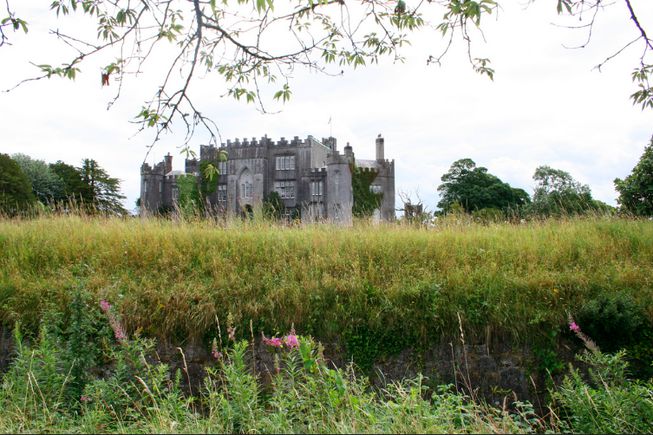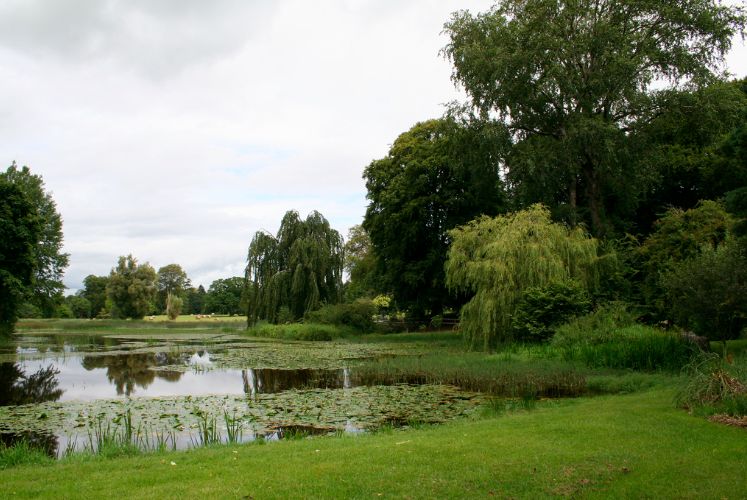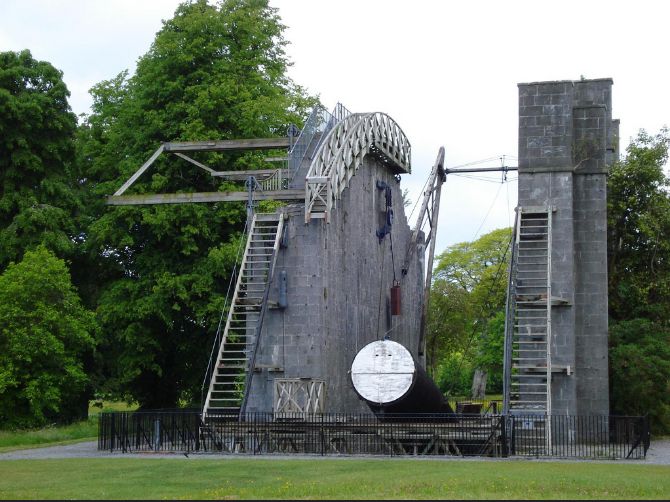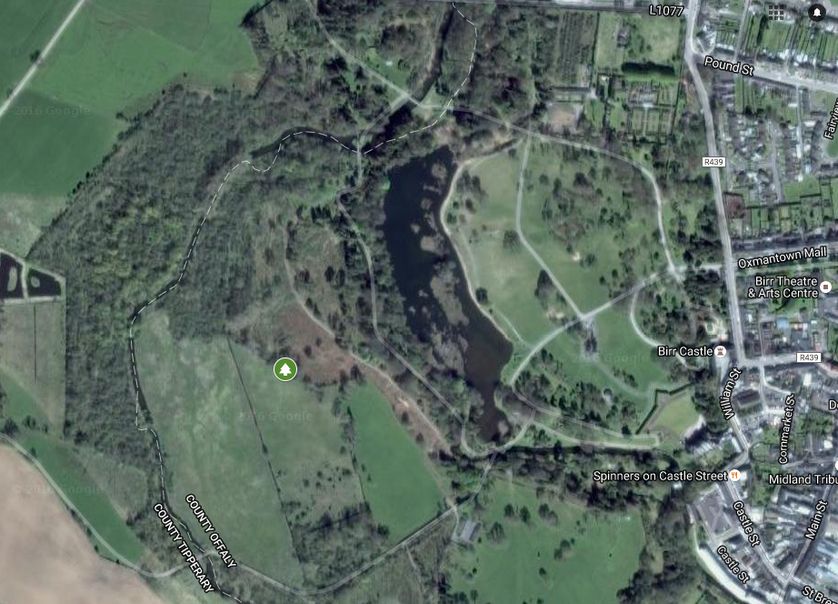Source: mnn.com
Published: December 1, 2016

The grounds of a medieval Irish castle might be the last place you’d think a couple thousand giant and coastal redwoods would be planted. But when you consider Birr Castle’s rich botanical legacy, it starts to make sense. (Photo: Jon Aker/flickr)
County Offaly will be the site of the 2,000-tree-strong Giants Grove.
Ireland, enchanted land of mist-shrouded bogs and dewy patches of trefoil spanning as far as the eye can see, isn’t exactly famous for being home to the mighty Sequoiadendron giganteum — the giant redwood. As far as natural distribution goes, these awe-inspiring ancient beauties are strictly limited to Northern California, specifically the western slopes of the Sierra Nevada.
Yet giant redwoods are indeed (kind of) native to Ireland, growing in great numbers across the Emerald Isle some three million years ago prior to the Ice Age. Beginning in the mid-19th century, giant redwoods staged a modest return to Ireland and Great Britain — most notably in Scotland — where, to this day, they are cultivated for ornamental purposes. That being said, giant redwoods can and do grow with some success in Ireland although there are no full-on forests — or significant groves for that matter —populated by these impossibly tall trees like in California.
This, however, will soon change.
The expansive grounds of Birr Castle in County Offaly are set to become home to the largest grove of giant redwoods outside of California with over 2,000 sky-brushing specimens. (For those with a shaky grasp on Irish geography, non-touristy Offaly county is located west of Dublin in the island republic’s sparely populated, bog-heavy Midlands Region.)

Mighty redwood trees, like those pictured here at Prairie Creek Redwoods State Park in Humboldt County, California, grew across Ireland and continental Europe millions of years ago. (Photo: Kirt Edblom/flickr)
Aptly dubbed Giants Grove in an apparent nod to the Grove of Titans in Del Norte County, California, the project is being heralded as “a living, enduring and inspiring tribute to Ireland’s diaspora.” Twenty-five percent of the plantings will consist of the giant redwood’s close — and also colossal — cousin, the coastal redwood or Sequoia sempervirens.
As the website for the ambitious endeavor explains, the return of these majestic trees to Ireland “will symbolise our hopes for visits home or even the return of cherished family members” while also serving as a “symbol of Ireland’s global concern for conservation, as climate change represents a threat to the long term survival of redwoods in California.”
Heavy — and as for the climate change bit, highly important — stuff. But what else would you expect from Ireland, an environmentally progressive country with a knack for both the poignant and the poetic?

The lush grounds of Birr Castle are home to thousands of species of plants both exotic and indigenous including a smattering of giant and coastal redwoods planted in the 1860s. (Photo: Jon Aker/flickr)
An arboreal monument to the Irish diaspora
While Giants Grove is co-partnered by Birr Castle and environmental nonprofit Crann — Trees for Ireland, the planting, maintenance and continual care of the 2,000 redwoods will be financially backed by the general public through a sponsorship program. Trees sponsors are implored to dedicate a tree to a loved one — ideally, but not exclusively, a member of the Irish diaspora currently living abroad — or to sponsor a tree in commemoration of a birth, anniversary or wedding. With each sponsored planting, recipients receive a certificate listing exact GPS coordinates that enable them to identify “their tree” from thousands of miles away.
Single spaces within Giant Groves go for 500 euros — about $530 dollars as of publication. As noted by Giants Grove, the cost will “help to create, to all of Ireland’s sons and daughters and their families, a national tribute of global significance that will symbolise the giant and lasting place that they have in this nation’s heart.” The project website goes as far to provide a map detailing countries around the world with significant Irish communities including the United Kingdom, America, Australia, Canada, South Africa and Spain. In essence, the trees are for these folks.
“We’re giving people the chance to put down roots in Ireland. Some families can’t afford to come home, but with these trees they are home,” volunteer project manager Clara Clark of Crann explains to the Irish Times in a fantastic article profiling this unlikely large-scale planting project. “I think that’s magical.”
The names of individuals for whom the trees are dedicated will also be listed in a Book of Honour on display at Birr Castle, a 90-room medieval compound that serves as the private residence of Brendan Parsons, 7th Earl of Rosse, and his family. In addition to being open for seasonal public tours when the Parsons clan is not in residence, the castle is also home to a science education center with a focus on engineering and astronomy.

Birr Castle’s Great Telescope, also known at the Leviathan of Parsonstown, was the largest reflecting telescope in the world for several decades starting in the mid-1800s. (Photo: bea & txema & alan/flickr)
Birr Castle: A hotbed of experimental planting and planet-peeping
A popular destination in a county and greater region where bona fide tourist attractions are relatively far and few between, Birr Castle is internationally renowned for its sprawling public gardens, which showcase a variety of rare, exotic and otherwise exceptional horticultural specimens including Ireland’s first native-to-China dawn redwood (Metasequoia) and the world’s tallest boxwood hedges. The walled-in castle grounds, formally known as the Birr Castle Demesne, are also home to a Victorian fernery, a nature trail-encircled lake, Ireland’s largest treehouse (!) and the Great Telescope (aka the Leviathan), an astronomical instrument built in 1845 by the 3rd Earl of Rosse. It reigned as the world’s largest reflecting telescope all the way through 1917.
Gorgeous scenery, rare plants from foreign lands and superlatively tall and large objects … sounds like the incoming redwoods will fit right in at Birr Castle.
“I think it’s a marvellous idea,” 80-year-old Brendan Parsons, whose own plant-hunting aristocratic ancestors curated and nurtured Birr Castle’s famed gardens, explains to the Irish Times. “We are experimenters by nature. Trying new things at Birr is an old tradition. It’s absolutely cut out for Birr, this. We never do what other people do. The redwood grove will add a fantastic new dimension to Birr Castle Demesne, in line with the projects we already have going here — and also because of the new concept of a different sort of diaspora, an arboreal diaspora.”
Parsons goes on to note that there are already nine giant and coastal redwoods currently growing at Birr Castle, all likely planted in the 1860s.
“I’ve often puzzled over why each one was planted where it was,” Parsons tells the Times. “I don’t think there was a concept of landscaping in those days. It was more a case of put one here, one there, and see how they’d go. But the ones that seem to thrive here are the coast redwoods. The tree that has done best in girth is in the wettest possible place.”

The site of Giants Grove, which is being planted in two phases. To the east is the town of Birr, previously known as Parsonstown. Birr Castle is located on the upper right part of the map, just below Pound Street. (Screenshot: Google Maps)
‘Why not try again?’
As for the planting plan for the new redwoods, it will be carried out in two phases on large tracts of land nestled in between existing oak woodlands opposite the estate’s lake and to the southwest of the castle proper. Work on the first phase has already kicked off with the physical planting scheduled for the spring of 2017. Fast-growing coastal redwoods, which, again, will comprise 25 percent of the 2,000 new trees, will be planted in three small groves. Six larger parcels will be home the giant redwood groves, which, in reality, will be more akin to lush, miniature forests.
Smaller native trees including holly and birch will be planted amongst the towering redwoods to fill out the newly planted mini-forest’s under-story and encourage biodiversity.
“We’re trying to make the planting as natural as possible,” elaborates Parsons. “I don’t want the grove to look like a forestry block, or a circle, or an avenue — and what we will be interspersing between the trees will be entirely native.”
Located directly adjacent to the quaint Georgian market town of Birr (née Parsonstown) but seemingly operating in its own tranquil universe, the demesne is home to a large and diverse range of wildlife including river otters, red squirrels, swans, kingfishers and badgers.
Click here to watch “Lord Rosse Giant’s Grove, Birr Castle”: https://youtu.be/2nXo-j3sCZk
Adjacent to the 20-acre planting site, which wedges up against neighboring County Tipperary, is the future Irish outpost of LOFAR, the world’s largest connected radio telescope with stations already up and running across Europe.
Telescopes aside, when asked by the Irish Times why the groves at Birr Castle will packed full with redwoods and not species that are native to Ireland such as alder, ash, birch and oak (the Sessile oak is Ireland’s national tree) for a monumental tree-planting project that serves as a living tribute to the Irish diaspora, Parsons had this to say: “It’s a returned native. It grew here about two or three ice ages ago, so why not try again?”
He adds: “I have the greatest respect for the trees that make the tallest, finest trees of all. And I think there can be little finer than the Sequoiadendron giganteum. And also I have a fascination for what will grow longest. I just love the idea of trying to succeed with a grove here that will last for literally thousands of years.”
